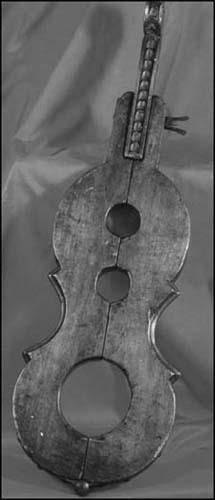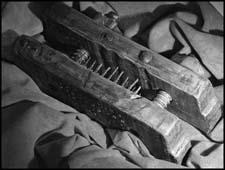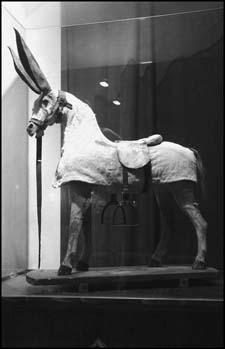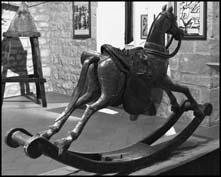The Big Book of Pain: Torture & Punishment Through History (40 page)
Read The Big Book of Pain: Torture & Punishment Through History Online
Authors: Daniel Diehl

Drunkard’s cloak
DUCKING STOOL
See ‘Ducking’ in the section ‘Torture by Water’.
FIDDLE AND FLUTE
These contraptions served as a sort of portable or mobile pillory (see overleaf). Once the victim was locked into them they could be paraded through the streets whilst being led by a chain and collar around their necks, etc. Sometimes they might even be trapped within these devices before being exiled from a particular city. Similar in that way to the Chinese
Cangue
discussed above, the victim (or victims) forced to wear one of these contraptions would be completely at the mercy of any passers-by. Furthermore, they would be incapable of feeding themselves and would, therefore, have to rely on the charity and generosity of those same passers-by for food and drink. It seems that this too was a punishment largely reserved for women of a shrewish temperament.

The fiddle.
JAGGS
See ‘Iron Collar’ in the section ‘Torture by Restraint’.
PENANCE
Defined in
Webster’s Dictionary
as ‘an act of self-abasement, mortification or devotion performed to show sorrow or repentance for sin’, penances were imposed on members of both the clergy and laity who were judged by the Church to be guilty of sins or criminal acts throughout the Middle Ages. Penances for small transgressions could be as mild as a short period of fasting and prayer or as great as taking a pilgrimage to some holy site. In worst case scenarios, such as one case where a Frenchman was found guilty of murdering his infant child, the condemned party had the body of the child chained to his back and was forced to walk all the way to Rome under the strict supervision of a priest and armed guards. Whether or not the man survived is unknown.

Iron fiddle.
PILLORY, FINGER
Designed to punish those who insisted on disrupting church services, the finger pillory consisted of two boards, hinged together and attached to the wall of a church. One of the boards had four holes drilled through it, spaced to accept a person’s fingers. In the opposite board were four corresponding grooves, or troughs, which closed over the fingers. It was hoped that once the hand of the offender was locked in place they would be a bit more attentive to the Word of God.

Finger pillory.

Pillory.
PILLORY
The pillory is a device wherein the condemned had their head and wrists locked into a wooden frame mounted on a shoulder-height post set up in a public place such as the local market square. Apparently it derived its name from a Greek phrase meaning ‘to look through a door’ – an appropriate description of someone with their head and hands poking through the front of the pillory. The first recorded use of the pillory took place in Classical Greece; the Anglo-Saxons called it the
healfang
(or half-hang) and it was in constant use throughout the Middle Ages – being codified as a legal form of punishment in England in 1269 by King Henry III – and continuing in use through the early nineteenth century all across Great Britain, Europe and the Americas. The pillory served as a method of punishing those convicted of minor crimes of all manners, be it public drunkenness, brawling, homosexuality, or disorderly conduct. Included in the myriad of petty offences for which a man or woman could be pilloried were, according to an eighteenth-century English statute: ‘those who sell putrid meat, stinking fish, rotting birds, and bread with pieces of iron in it to increase its weight’. In the old Dutch colony of New York a man convicted of stealing cabbages was sent to the pillory with a cabbage tied to his head. While the victim was on public display – a period that could last from a single hour to more than a week – they were subjected to the taunts of their neighbours and, depending upon how offensive their crime was, frequently pelted with rotten vegetables, mud and stones. In some instances, the abuse to which a pilloried individual was subjected was so severe that they were knocked unconscious and ran the risk of strangling to death when the full weight of their bodies came down on their imprisoned neck. One such incident took place at London’s Smithfield Horse Market in the eighteenth century, when two men, James Eagan and James Salmon, were pelted with stones, potatoes, bricks and dead animals.

Double fiddle.
According to an eyewitness account: ‘The blows they received occasioned their heads to swell to an enormous size; and by people hanging to the skirts of their clothes they were nearly strangled’. Eagan died on the spot and Salmon died in prison a short time later. Only a few years after the Eagan/Salmon incident, a homosexual man was pilloried and was pummelled so badly that he: ‘soon grew black in the face and blood issued from his nostrils, his eyes and his ears; the mob nevertheless attacked him with great fury’. When the pillory was unlocked he: ‘Fell down dead on the stand of the instrument’. The pillory could also serve as one part of a larger series of punishments. Some who were pilloried were also whipped and others had their ears nailed to the back-board of the pillory, only to be torn free or cut off when the sentence was concluded.

Donkey – stang.
RIDING THE STANG
With so many punishments specifically levied against uncouth women it seems only fair that wife-beating men and tavern brawlers should also be subjected to an equivalent humiliation – hence Riding the Stang. The stang was nothing but a length of log, or a stout pole, which the victim was forced to straddle while he was carried through the streets of his town, accompanied by merrymakers shouting, cat-calling, blowing horns and whistles to call attention to their thoroughly embarrassed captive.

Rocking horse – stang.
Other variations on this form of torture and humiliation were put into play for military punishments, the most extreme of which is sometimes referred to as the Spanish donkey. In this case the ‘stang’ took the form of a wooden horse (sometimes with wheels and sometimes with rockers) and it would either have a spiked seat or perhaps even have been a simple V-shaped wedge. The malefactor would be forced to straddle the ‘horse’ with their arms bound behind their back and they would ride the devilish contraption while others rocked or wheeled them about. Additional torment was frequently obtained though the addition of heavy weights on the ‘rider’s’ feet.
